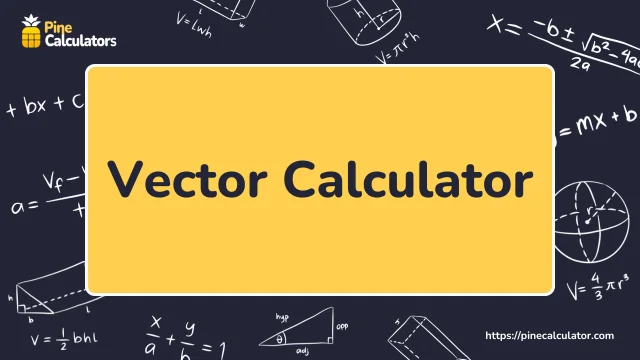Introduction to Vector Calculator:
Vector Calculator is an online tool designed to help you calculate vector questions in a few seconds. Our tool determines the basic operations (e.g., determine the vector addition, subtraction, multiply, magnitude, direction, and projection) that perform on the vector.

The vector solver is a powerful tool for students, teachers, or researchers because it is used in various fields such as mathematics, physics, engineering, and computer science for representing quantities such as force, velocity, and displacement.
What is a Vector?
A vector is a mathematical quantity with both the magnitude and direction in three-dimensional space. It can be mathematically represented by arrows and the bold letter A. It can be indicated by hand and foot rule to show the magnitude or direction of a vector.
Vectors are in two dimensions expressed as v = ⟨v1, v2⟩ and in three dimension vectors are v = ⟨v1, v2, v3⟩.
How to Calculate Vectors?
For the calculation of vectors for different operations such as addition, subtraction, scalar multiplication, dot product, and cross product. There are the steps used by the vector calculator to perform this basic arithmetic operation with vectors. The Vector Operations are:
How to Add Vectors?
In the addition of two vectors A and B, the vectors calculator adds their corresponding components i,j, and k. Let’s understand with the help of an example.
For example a = ⟨2i, 3j⟩, and b = ⟨4i, 3j⟩ for the addition of vector.
$$ a + b \;=\; (2 + 4)i, \; (3 + 3)j $$
$$ =\; 6i,\; 6j $$
How to Subtract Vectors?
For the subtraction of vector b from vector a, the vector graphing calculator subtracts their corresponding components. For Example: Given vector subtraction is, a = ⟨5, 7⟩ and b = ⟨2, 3⟩
$$ a − b \;=\; (5 − 2)i,\; (7 − 3)j $$
$$ =\; (3i,\; 4j) $$
How to Multiply Vectors?
To multiply a vector by a scalar, the vector calculator multiplies each component by the scalar because a scalar function has no direction.
Example:
Given v = ⟨3, −2⟩ and scalar k = 4
$$ kv \;=\; 4 (3i,− 2j) $$
$$ =\; (12i,− 8j) $$
Dot Product
The vectors graph calculator calculates the dot product of two vectors a and b as:
For 2D vectors:
$$ a ⋅ b \;=\; (ax \boldsymbol i. bx \boldsymbol i) + (ay \boldsymbol j . by \boldsymbol j) $$
For 3D vectors:
$$ a ⋅ b \;=\; (ax \boldsymbol i . bx \boldsymbol i) + (ay \boldsymbol j . by \boldsymbol j) + (azk . bzk) $$
Example:
Given a = (i, 2j, 3k) and b = (4i, −5j, 6k)
$$ a \cdot b \;=\; (1i) \cdot (4i) + (2j) \cdot (−5j) + (3k) \cdot (6k) $$
$$ Since \;\; i . i \;=\; 1 , j . j \;=\; 1 , k . k \;=\; 1 $$
$$ =\; 4 − 10 + 18 $$
$$ =\; 12 $$
Cross Product (only for 3D vectors):
The vector graphing calculator gives the result of cross product of two vectors a and b as a vector that is perpendicular.
$$ a \times b \;=\; (aybz − azby)i\; - \;(azbx − axbz)j\; + \;(axby−aybx)k $$
Example:
Given a = ⟨1, 2, 3⟩ and b = ⟨4, 5, 6⟩
$$ a \times b \;=\; (2 ⋅ 6 − 3 ⋅ 5)i\; - (3⋅4 − 1⋅6) + (1⋅5−2⋅4)k $$
$$ =\; (12−15)i\; - (12−6)j\; + (5−8)k $$
$$ =\; (-3i - 6j + -3k) $$
These basic operations form the basis for many practical applications of vectors in various fields such as physics, engineering, and computer science.
How to Use Vector Calculator?
The vector solver has the simplest design that allows you to calculate the vector question for basic operation. Follow some of our simple steps before using it to find the solution to vector questions. These steps are:
- Choose the method that you want to evaluate for the vector problem from the given list of vectors calculator.
- Enter the value of vector A in the input field.
- Enter the value of vector B in the input field.
- Review your vector value before pressing the calculate button so that you get the exact solution without any mistakes in the calculation process.
- Click on the “Calculate” button to get the solution of the vector problem.
- Click on the “Recalculate” button to get a new page for more evaluation of the vector questions.
- If you want to check the accuracy of the solution then you should first try out the load example of the vectors graph calculator.
Final Result of Vector Solver:
Vector Calculator gives you a solution to your given vector problem when you click on the calculated button. It may include the following:
- Result Option:
Result option provides you with solutions for vector problems.
- Possible Steps:
Possible steps provide you with solutions to vector questions in a step-wise process.
Useful Feature of Vectors Calculator:
The vector graph calculator has serval useful features when you use it to calculate the vector question in arithmetic operation and get its solution. These useful features help you in getting in-depth knowledge about the vector question for a better understanding.
- The vector math calculator saves the time and energy that you consume when you do vector calculations manually.
- Our vector graphing calculator can operate through a computer, laptop, or mobile which makes it a convenient tool for everyone.
- Vector solver has a user-friendly interface so that you can calculate vectors in addition, subtraction, multiply, and magnitude of vector problems easily.
- It provides you the exact results as per your given input question for the vector question with a solution.
- Vector calculator is an educational tool that gives you solutions in the step-by-step method so that you can easily familiar with the concept of the vector.










